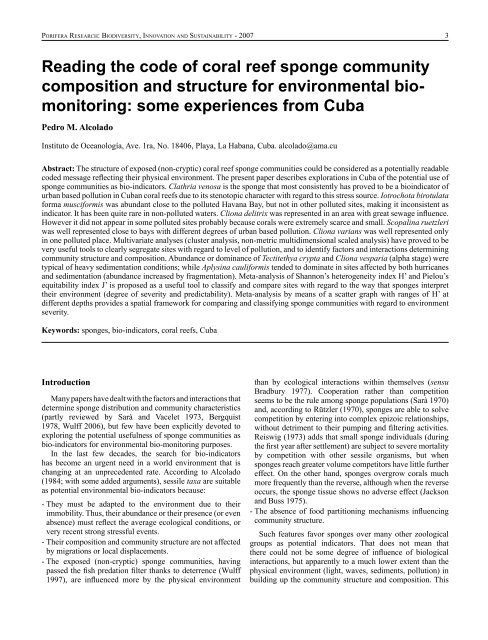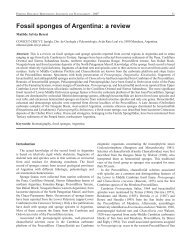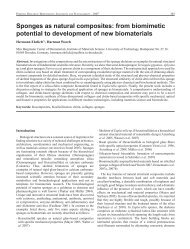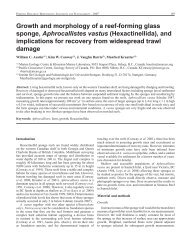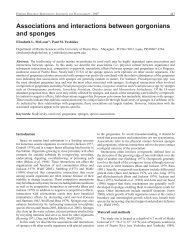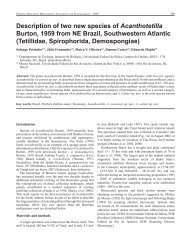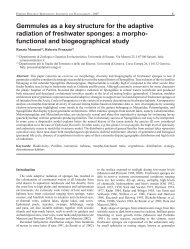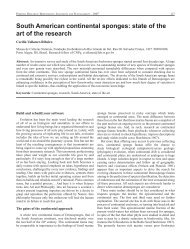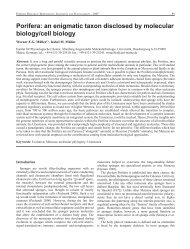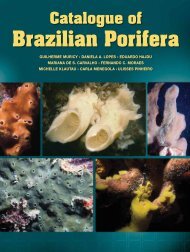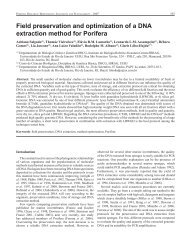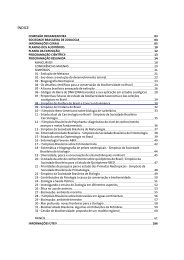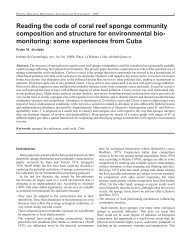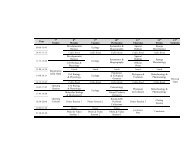- Page 2 and 3: Universidade Federal do Rio de Jane
- Page 4: Borojevic, Roberto Berlinck and Sol
- Page 10 and 11: viHeinz C. Schröder, Anatoli Krask
- Page 14 and 15: also makes community structure and
- Page 17 and 18: (e.g., Cliona aprica, among sponges
- Page 19 and 20: hidrodinámica sobre los organismos
- Page 21 and 22: Porifera Research: Biodiversity, In
- Page 23 and 24: 13Fig. 2: A. Cambrian anthaspidelli
- Page 25 and 26: 15conditions point to low energy, s
- Page 27 and 28: 17Table 1: Biogeographic distributi
- Page 29: 19Fig. 5: Oxfordian hexactinellidsp
- Page 33 and 34: Porifera Research: Biodiversity, In
- Page 35 and 36: 25Fig. 2: Polymastia harmelini sp.
- Page 37 and 38: has a mesh of 0.03 µm in diameter
- Page 39 and 40: 29Fig. 9: Polymastia harmelinisp. n
- Page 41 and 42: Porifera Research: Biodiversity, In
- Page 43 and 44: 33Table 1 (cont.)Chalinidae 7 Halic
- Page 46 and 47: 36Table 2: Spicule measurements of
- Page 48 and 49: 38Fig. 3: Filamentous cyanobacteria
- Page 51 and 52: Porifera Research: Biodiversity, In
- Page 53 and 54: 43Fig. 3: German spongiologsportrai
- Page 55 and 56: larvae have a strongly pronounced a
- Page 57 and 58: 47Fig. 9: Semi-thin micrographsof d
- Page 59 and 60: Fig. 11: Diagram of spongescleavage
- Page 61 and 62: 51Degnan BM, Leys SP, Larroux C (20
- Page 63 and 64:
Porifera Research: Biodiversity, In
- Page 65 and 66:
55Fig. 1: Dilation and contraction
- Page 67 and 68:
57Fig. 3: A, B. The actin cytoskele
- Page 69:
59Mechawar N, Anctil M (1997) Melat
- Page 72:
62(Simpson and Fell 1974, Manconi a
- Page 75 and 76:
65Table 1 (cont.)S. permixta Weltne
- Page 77 and 78:
67Table 1 (cont.)Potamophloios Brie
- Page 79 and 80:
69Fig. 4: Geographic distribution o
- Page 81 and 82:
71Fig. 6: The gemmule structureof S
- Page 83 and 84:
73Fig. 8: Pattern of geographicdist
- Page 85 and 86:
75(Pansini and Pronzato 2002). This
- Page 87:
77Resh VH, Morse JC, Wallace JD (19
- Page 90 and 91:
80chemical principles might be invo
- Page 92 and 93:
82Table 1: Glycan structures obtain
- Page 94 and 95:
84Fig. 4: Glyconectin glycoconjugat
- Page 96 and 97:
86Fig. 6: Species-specific glyconec
- Page 98 and 99:
88Moscona AA (1968) Cell aggregatio
- Page 100 and 101:
90solid support, the spicules, is c
- Page 102 and 103:
92Fig. 2: Different stages of morph
- Page 104 and 105:
94protein; Wiens et al. 2003b, or F
- Page 106 and 107:
96Ser/Thr directed mitogen-activate
- Page 108 and 109:
98Fig. 5: Sponge stem cell system.
- Page 110 and 111:
100share high sequence similarity t
- Page 112 and 113:
102the retinoid X receptor (RXR) wa
- Page 114:
104MM (eds). Cell and tissue intera
- Page 117 and 118:
Porifera Research: Biodiversity, In
- Page 119 and 120:
109due to the presence of placochel
- Page 121 and 122:
111
- Page 123 and 124:
113Fig. 2: Reproductive stages in A
- Page 125:
115Lundbeck W (1905) Porifera. Pars
- Page 128 and 129:
118poriferan biodiversity (Hooper a
- Page 130 and 131:
120spicules, particularly in the Am
- Page 133 and 134:
Porifera Research: Biodiversity, In
- Page 135 and 136:
125Such a system could also enable
- Page 137 and 138:
Fig. 3: Record #167 from the Sponge
- Page 139:
RESEARCH ARTICLES
- Page 142 and 143:
132(Randall and Hartman 1968, Dunla
- Page 144 and 145:
134Fig. 2: Curves of accumulated ri
- Page 146 and 147:
136tricolor; data not shown) and in
- Page 149 and 150:
Porifera Research: Biodiversity, In
- Page 151 and 152:
141Fig. 1: Size of “phallus” fo
- Page 153 and 154:
Fig. 5: Various forms of A. vastus
- Page 155:
AcknowledgementsOur thanks to Paula
- Page 158 and 159:
148Material and methodsSpecimens of
- Page 160 and 161:
150Fig. 2: Haliclona sonorensis- Ge
- Page 162 and 163:
152Fig. 4: A. Haliclona caerulea- J
- Page 164 and 165:
154Fig. 5: A. Symbiotic association
- Page 166:
156Maldonado M, Uriz MJ (1998) Micr
- Page 169 and 170:
Table 1: List of the Demosponge spe
- Page 171 and 172:
161
- Page 173 and 174:
163Fig. 3: Environmental variations
- Page 175 and 176:
Porifera Research: Biodiversity, In
- Page 177 and 178:
167Fig. 1: A. Ammonia and nitrate e
- Page 179 and 180:
169
- Page 181:
171Hentschel U, Fieseler L, Wehrl M
- Page 185 and 186:
175Fig. 1A-D: Sponges examined in t
- Page 187 and 188:
177have co-evolved with the host sp
- Page 189 and 190:
Porifera Research: Biodiversity, In
- Page 191 and 192:
181Fig. 1: Lubomirskia baikalensis.
- Page 193 and 194:
183Fig. 3: Phylogenetic relationshi
- Page 195 and 196:
185Fig. 5: Microscopical analysisof
- Page 197 and 198:
187Laboratory” is open for the sc
- Page 199 and 200:
Porifera Research: Biodiversity, In
- Page 201 and 202:
191Fig. 2: A, B. Specimens ofCranie
- Page 203 and 204:
193Fig. 4: A. Specimen of Myxilla(M
- Page 205 and 206:
195Fig. 6: A. Specimen of Tedania(T
- Page 207 and 208:
197Fig. 8: Tedania (Tedaniopsis)sar
- Page 209 and 210:
199the tornotes in T. armata are al
- Page 211:
201Gillan DC, Ebbe B, Howe JA, Janu
- Page 214 and 215:
204different mineral composition, t
- Page 216 and 217:
206Fig. 4: The maximumvertical pene
- Page 218 and 219:
208Fig. 6: Polarized light micropho
- Page 220 and 221:
210boring activity of Cliona lampa
- Page 222 and 223:
212in the maintenance of diversity
- Page 224 and 225:
214Fig. 4: Density of Echinometra l
- Page 226 and 227:
216other invertebrates are abundant
- Page 229 and 230:
Porifera Research: Biodiversity, In
- Page 231 and 232:
221Fig. 2: Iophon terranovae Calcin
- Page 233 and 234:
223Fig. 4: Myxilla (Ectyomyxilla)ma
- Page 235 and 236:
225Fig. 6: Isodictya erinacea(Topse
- Page 237 and 238:
227Fig. 8: Haliclona (Rhizoniera)da
- Page 239 and 240:
229Fig. 10: Microxina benedeniTopse
- Page 241 and 242:
231South Atlantic localities (South
- Page 243 and 244:
Porifera Research: Biodiversity, In
- Page 245 and 246:
235
- Page 247:
237intertidal coral reef areas. The
- Page 250 and 251:
240We can classify soft bottom spon
- Page 252 and 253:
242get stabilization, produces more
- Page 254 and 255:
244Fig. 3: Sponges living both on h
- Page 256 and 257:
246Haywick DW, Mueller EM (1997) Se
- Page 258 and 259:
248penetrates deeply (down to 10-12
- Page 260 and 261:
250Fig. 3: Underwater photographsof
- Page 262 and 263:
252Fig. 5: Photomicrograph of agrou
- Page 264 and 265:
254para su conservación. Colecció
- Page 266 and 267:
256input, and temperature (Risk and
- Page 268 and 269:
258(e) = (r i− P i)/(r i+ P i), w
- Page 270 and 271:
260Table 3: Stony coral colonizatio
- Page 272 and 273:
262rapidly than coral colonies can
- Page 275 and 276:
Porifera Research: Biodiversity, In
- Page 277 and 278:
267Fig. 3: Surface of macerated Spo
- Page 279 and 280:
269Fig. 13: Fine filaments with swo
- Page 281 and 282:
271to Ircinia, and are uncored or h
- Page 283 and 284:
273Thorectaxia - unarmoured thorect
- Page 285 and 286:
Porifera Research: Biodiversity, In
- Page 287 and 288:
277Fig. 3: Megasclere set of Stelle
- Page 289 and 290:
279Fig. 5: Microscleres of the stud
- Page 291 and 292:
Porifera Research: Biodiversity, In
- Page 293 and 294:
283the maintenance of an organizati
- Page 295 and 296:
285out (excurvation) through the op
- Page 297 and 298:
287architecturally closer to the re
- Page 299 and 300:
289array over about 50 kilobases (k
- Page 301 and 302:
291EmH-3 promoter was active in K56
- Page 303 and 304:
293Ereskovsky AV, Gonobobleva EL (2
- Page 305:
295Richelle-Maurer E, van de Vyver
- Page 308 and 309:
298However, regardless of the farmi
- Page 310 and 311:
300it appeared that fish, probably
- Page 312 and 313:
302of Primary Industries and Fisher
- Page 314 and 315:
304of consolidated silica nanoparti
- Page 316 and 317:
306to now, the common technique for
- Page 318 and 319:
308Fig. 3: A. Wide field fluorescen
- Page 320 and 321:
310Fig. 5: Three photographs of 3D
- Page 322 and 323:
312of chitin as a component of the
- Page 324 and 325:
314Materials and methodsSpecies col
- Page 326 and 327:
316Table 3: Antimitotic activity of
- Page 328 and 329:
318Faulkner DJ (2000) Marine natura
- Page 330 and 331:
320organisms at a limited number of
- Page 332 and 333:
322Fig. 2: Examples of sponge growt
- Page 334 and 335:
324Table 3: List of sponge species
- Page 337 and 338:
Porifera Research: Biodiversity, In
- Page 339 and 340:
329Fig. 3: Growth forms of Halichon
- Page 341 and 342:
331Fig. 5: Growth forms of Halichon
- Page 343:
333water temperature at 8-12 m dept
- Page 346 and 347:
336Sutherland et al. 2004, Kaczmars
- Page 348 and 349:
338Table 1: Distribution and abunda
- Page 350 and 351:
340Table 3: Comparison of nutrient
- Page 352 and 353:
342region. Our measurements of pote
- Page 355 and 356:
Porifera Research: Biodiversity, In
- Page 357 and 358:
347
- Page 359 and 360:
349Fig. 4: A, B. Prelarva. Longitud
- Page 361:
351the data on the presence of calc
- Page 364 and 365:
354Table 1: List of Brazilian deep-
- Page 366 and 367:
356Table 2: Classification of Porif
- Page 368 and 369:
358Table 3: List of Brazilian deep-
- Page 371 and 372:
Porifera Research: Biodiversity, In
- Page 373 and 374:
363
- Page 375 and 376:
Table 2: Molecular markers analysed
- Page 377 and 378:
12SIn case of the mitochondrial 12S
- Page 379 and 380:
369Fig. 5: A. 50% majority rule con
- Page 381:
371dibromotyrosine-derived alkaloid
- Page 384 and 385:
374effect was achieved, as the DNA
- Page 386 and 387:
376Fig. 2: Alignment of the three s
- Page 389 and 390:
Porifera Research: Biodiversity, In
- Page 391 and 392:
381Fig. 3: Left: 3x2 replicated oxy
- Page 393 and 394:
Porifera Research: Biodiversity, In
- Page 395 and 396:
385indicate that the order Haploscl
- Page 397 and 398:
387Table 1 (cont.)Haliclona oculata
- Page 399 and 400:
389Fig. 2: Neighbour-joining phylog
- Page 401:
391Kaygorodova IA, Sherbakov DY, Ve
- Page 404 and 405:
394identified from siliceous microf
- Page 406 and 407:
396Table 1: Classification and chec
- Page 408 and 409:
398Table 3: Geographic distribution
- Page 410 and 411:
400Fig. 2: Box and Whisker plots of
- Page 412 and 413:
402primary and secondary production
- Page 414 and 415:
404development of marine compounds
- Page 416 and 417:
406nitrogen and total RNA was extra
- Page 418 and 419:
408Table 1: Examples of the clones
- Page 420 and 421:
410Fig. 1: The declinations of the
- Page 422 and 423:
412Nichols SA, Dirks W, Pearse JS,
- Page 424 and 425:
414Fig. 1: Study area (Source: Onli
- Page 426 and 427:
416Fig. 5: Photomicrographs of the
- Page 428 and 429:
418Anakina RP, Drozdov AL (2001) Ga
- Page 430 and 431:
420from the community existing in t
- Page 432 and 433:
422Fig. 3). We also found some evid
- Page 434 and 435:
424changes in species richness. The
- Page 437 and 438:
Porifera Research: Biodiversity, In
- Page 439 and 440:
429Fig. 2: Chemical equationfor the
- Page 441 and 442:
431as a biomarker, since the propos
- Page 443 and 444:
Porifera Research: Biodiversity, In
- Page 445 and 446:
ResultsSpectrum 1 H-NMR analysis of
- Page 447:
ReferencesAbourriche A, Charrouf M,
- Page 450 and 451:
440January 2004. According to Salva
- Page 452 and 453:
442Hooper JNA, Lévi C (1994) Bioge
- Page 454 and 455:
444This site has no emergent reefs,
- Page 456 and 457:
446species are equivalent to their
- Page 458 and 459:
448Connell JH (1978) Diversity in t
- Page 460 and 461:
450Fig. 1: Distribution of Calycoso
- Page 462 and 463:
452Table 2: Some mesures of spicule
- Page 464 and 465:
454Table 3: Some measures of spicul
- Page 466 and 467:
456Fig. 5: Spicules of the holotype
- Page 468 and 469:
458Fig. 6: Spicules of Lophocalyxbr
- Page 470 and 471:
460Fig. 8: Spicules of Lophocalyxat
- Page 472 and 473:
462Fig. 10: Spicules of Lophocalyxr
- Page 474 and 475:
464DiscussionRemarks on the new tax
- Page 477 and 478:
Porifera Research: Biodiversity, In
- Page 479 and 480:
469
- Page 481 and 482:
471Collection and identificationSpo
- Page 483 and 484:
473of algae and other sponges were
- Page 485:
475Mothes B, Lerner C (1999) Erylus
- Page 488 and 489:
478was described by minimum, mean a
- Page 490 and 491:
480Fig. 4: Length frequency distrib
- Page 492 and 493:
482the original description of the
- Page 494 and 495:
484Esnault 1976, Bergquist and Gree
- Page 496 and 497:
486Fig. 1: H. dujardini earlymetamo
- Page 498 and 499:
488Fig. 3: Laser confocal microscop
- Page 500 and 501:
490Halisarcida). In: Pansini M, Pro
- Page 502 and 503:
492July 2003, at Ferrol (Spain) in
- Page 504 and 505:
494Fig. 2: Elution profile from DEA
- Page 506 and 507:
496Bradford MM (1976) A rapid and s
- Page 508 and 509:
498Materials and methodsSponges and
- Page 510 and 511:
500Fig. 3: Change in outer appearan
- Page 512 and 513:
502Osinga R, Belarbi EH, Molina Gri
- Page 514 and 515:
504are touched repeatedly, they fee
- Page 516 and 517:
506Fig. 6: Creeping of isolated sam
- Page 518 and 519:
508Fry WG (1979) Taxonomy, the indi
- Page 520 and 521:
510Fig. 1: Map showing the typeloca
- Page 522 and 523:
512Table 1: Spicule measurements in
- Page 524 and 525:
514Table 2: Measurements, in μm (m
- Page 527 and 528:
Porifera Research: Biodiversity, In
- Page 529 and 530:
519pear as typically stylote. Lengt
- Page 531 and 532:
521Fig. 12: Diagram of positional t
- Page 533:
523the abfrontal surface. The front
- Page 536 and 537:
526Fig. 1: Maps of Bentart and Gebr
- Page 538 and 539:
528Fig. 2: Myxilla (Myxilla) elonga
- Page 540 and 541:
530Fig. 4: Type of Myxilla (Myxilla
- Page 542 and 543:
532Fig. 6: Myxilla (Burtonanchora)a
- Page 544 and 545:
534Table 3: Spicule micrometries of
- Page 546 and 547:
536Fig. 9: Myxilla (Burtonanchora)m
- Page 548 and 549:
538Fig. 11: Myxilla (Burtonanchora)
- Page 550 and 551:
540Fig. 13: Myxilla (Burtonanchora)
- Page 552 and 553:
542Fig. 15: Myxilla (Burtonanchora)
- Page 554 and 555:
544Fig. 17: Myxilla (Ectyomyxilla)h
- Page 556 and 557:
546Cristobo FJ, Urgorri V, Solórza
- Page 558 and 559:
548Sustainable Resources of the Eco
- Page 560 and 561:
550Fig. 2: Cinachyra helena sp. nov
- Page 562 and 563:
552Ceará does not mention the two
- Page 565 and 566:
Porifera Research: Biodiversity, In
- Page 567 and 568:
557Fig. 2: DNA quality state determ
- Page 569 and 570:
559Fig. 5: DNA quantification andsc
- Page 571 and 572:
Porifera Research: Biodiversity, In
- Page 573 and 574:
563Table 1: Detection of microorgan
- Page 575 and 576:
565Fig. 2: Transmission electron mi
- Page 577 and 578:
567similar (Fig. 3A, B). However, s
- Page 579 and 580:
Porifera Research: Biodiversity, In
- Page 581 and 582:
571Fig. 1: Live Cliona orientalisco
- Page 583 and 584:
573Fig. 3: Chlorophyll a fluorescen
- Page 585 and 586:
Table 2: Statistical results of tes
- Page 587 and 588:
577Fig. 5: Width of the dark browns
- Page 589 and 590:
AcknowledgementsThe study was condu
- Page 591 and 592:
Porifera Research: Biodiversity, In
- Page 593 and 594:
583cathepsin L sequence from S. dom
- Page 595 and 596:
585Fig. 8: Silicase. Alignment of t
- Page 597 and 598:
587Fig. 12: Spicule-associated prot
- Page 599 and 600:
589(Tahir et al. 2004). The recombi
- Page 601 and 602:
591Bhattacharyya P, Vulcani BE (198
- Page 603 and 604:
Porifera Research: Biodiversity, In
- Page 605 and 606:
595Fig. 1: Map of South Americancoa
- Page 607 and 608:
597Table 1 (cont.)Protriaene Anatri
- Page 609 and 610:
599it in place. The upper ends of s
- Page 611 and 612:
601between bundles of cortical oxea
- Page 613 and 614:
Porifera Research: Biodiversity, In
- Page 615 and 616:
605that this may have happened in T
- Page 617 and 618:
of species that have had their geno
- Page 619 and 620:
609future challenges. With world-wi
- Page 621 and 622:
611Duran S, Pascual M, Turon X (200
- Page 623 and 624:
Porifera Research: Biodiversity, In
- Page 625 and 626:
615Fig. 2: Map of the Kosterfjord (
- Page 627 and 628:
617reproductive M:F fraction hence
- Page 629 and 630:
619Fig. 5: Annual reproductive cycl
- Page 631 and 632:
Porifera Research: Biodiversity, In
- Page 633 and 634:
623Fig. 1: Neighbor-joining phyloge
- Page 635 and 636:
625hypothesis of cospeciation. If a
- Page 637 and 638:
Porifera Research: Biodiversity, In
- Page 639 and 640:
629larger pieces including both ect
- Page 641 and 642:
631(STID)” (Haukioja 1980, Clause
- Page 643 and 644:
wound-activated conversion is only
- Page 645 and 646:
635Fattorusso E, Minale L, Sodano G
- Page 647:
637Thompson JE, Murphy PT, Bergquis
- Page 650 and 651:
640Table 1: Review of the largest s
- Page 652 and 653:
642the same species no primmorphs f
- Page 655 and 656:
Porifera Research: Biodiversity, In
- Page 657 and 658:
647
- Page 659 and 660:
649Fig. 2: Rossella nodastrellaTops
- Page 661 and 662:
651Fig. 4: Quantitative presence of
- Page 663 and 664:
Porifera Research: Biodiversity, In
- Page 665 and 666:
Polyacrylamide gel electrophoresisT
- Page 667 and 668:
657Fig. 4: Agarose gel electrophore
- Page 669:
659Usher KM, Sutton DC, Toze S, Kuo
- Page 672 and 673:
662Hentschel, Ute..................
- Page 675 and 676:
665Subject Index#12S 361, 362, 364,
- Page 677 and 678:
667Cacospongia scalaris 265Calcarea
- Page 679 and 680:
669Cytochrome oxidase 124, 180, 361
- Page 681 and 682:
671Geodia barretti 613, 615-617, 61
- Page 683 and 684:
673Lendenfeldia dendyi 33Lendenfeld
- Page 685 and 686:
675Ordovician 11-20, 109, 114Organe
- Page 687 and 688:
677Sanidastra yokotonensis 64Sarcot
- Page 689 and 690:
679Tentorium semisuberites 380, 381
- Page 691 and 692:
681
- Page 693 and 694:
Hajdu, Karina (218)Harper, Mary Kay


